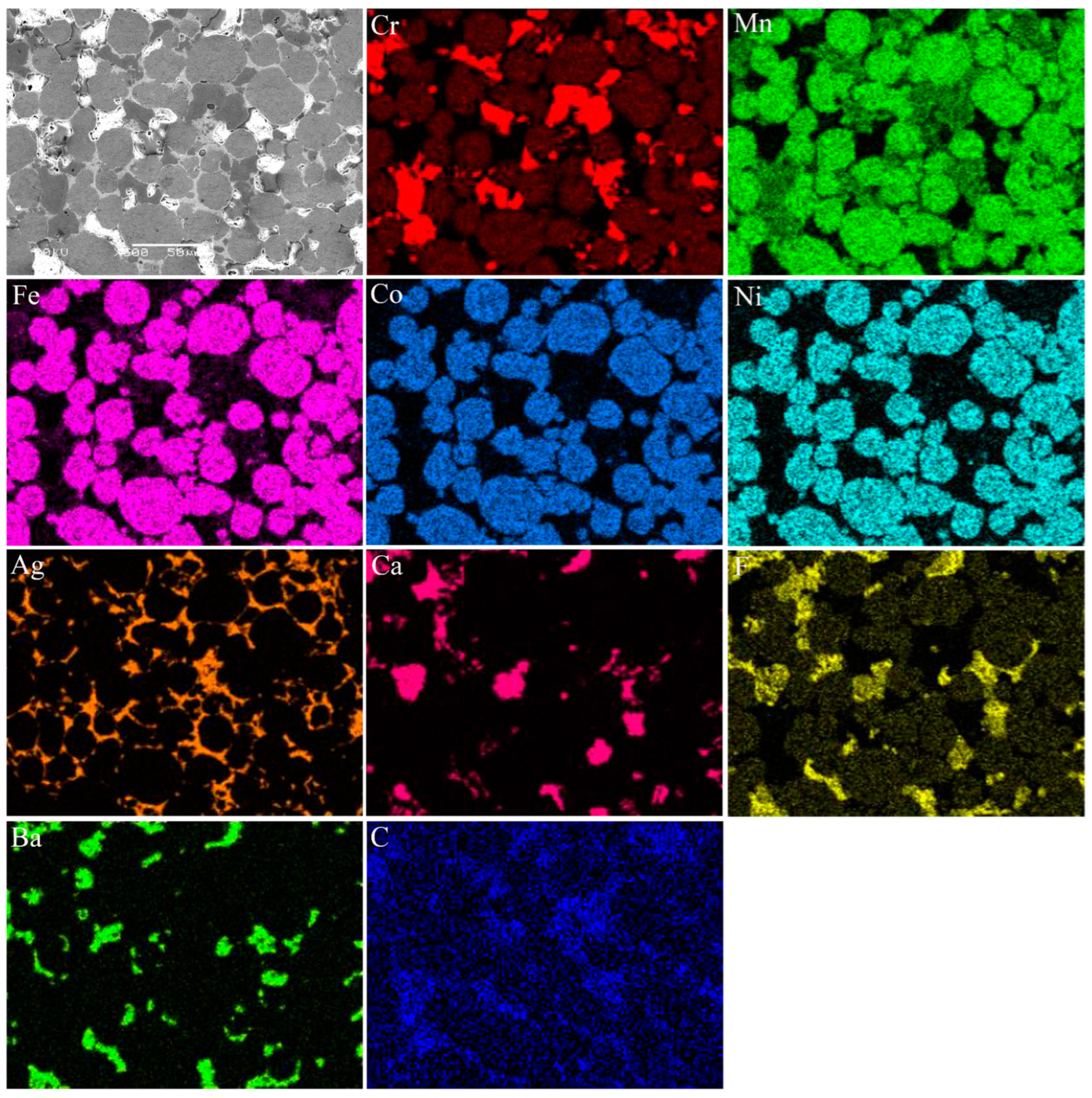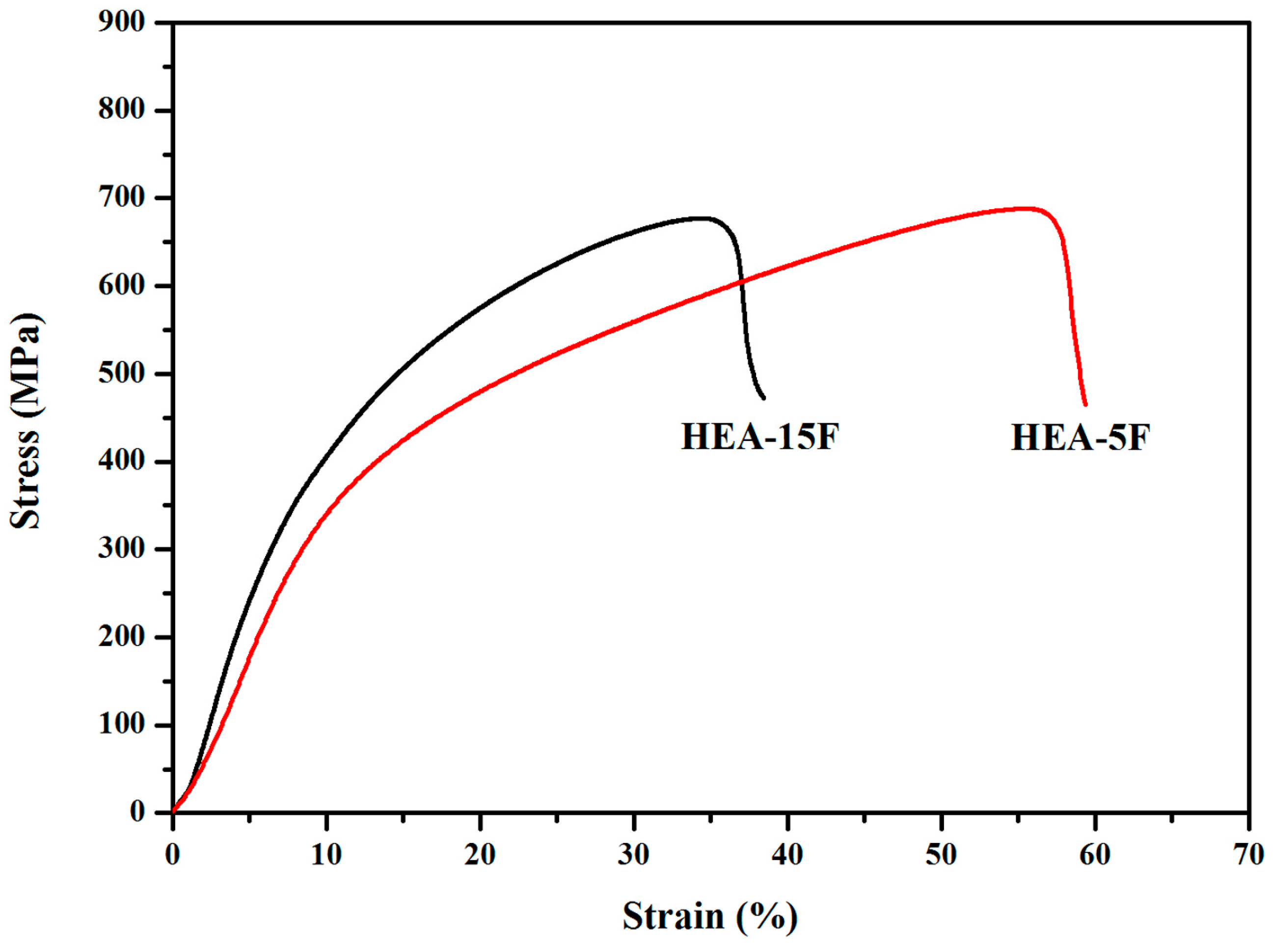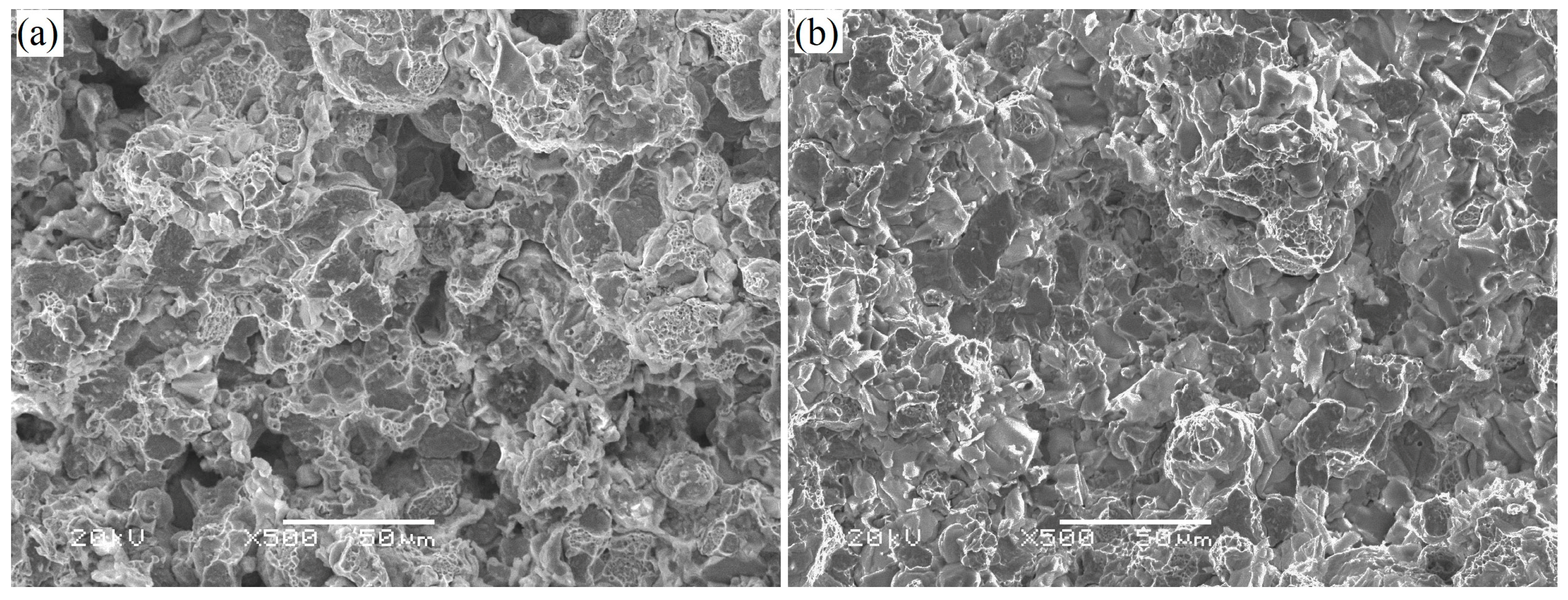The Microstructure and Mechanical Properties of High Entropy Alloy CoCrFeNiMn Matrix with Cr3C2 Reinforcement and Ag, BaF2/CaF2 Solid Lubrication
Abstract
:1. Introduction
2. Materials and Methods
3. Results and Discussion
3.1. Phase Composition
3.2. Microstructure
3.3. Mechanical Properties
4. Conclusions
Author Contributions
Funding
Institutional Review Board Statement
Informed Consent Statement
Data Availability Statement
Conflicts of Interest
References
- Zhu, S.Y.; Cheng, J.; Qiao, Z.H.; Yang, J. High temperature solid-lubricating materials: A review. Tribol. Int. 2019, 133, 206–223. [Google Scholar] [CrossRef]
- Shi, X.L.; Yao, J.; Xu, Z.S.; Zhai, W.Z.; Song, S.Y.; Wang, M.; Zhang, Q.X. Tribological performance of TiAl matrix self-lubricating composites containing Ag, Ti3SiC2 and BaF2/CaF2 tested from room temperature to 600 °C. Mater. Des. 2014, 53, 620–633. [Google Scholar] [CrossRef]
- Torres, H.; Ripoll, M.R.; Prakash, B. Tribological behavior of self-lubricating materials at high temperatures. Int. Mater. Rev. 2018, 63, 309–340. [Google Scholar] [CrossRef]
- John, M.; Menezes, P.L. Self-Lubricating Materials for Extreme Condition Applications. Materials 2021, 14, 5588. [Google Scholar] [CrossRef] [PubMed]
- Kumar, R.; Antonov, M. Self-lubricating materials for extreme temperature tribo-applications. Mater. Today Proc. 2021, 44, 4583–4589. [Google Scholar] [CrossRef]
- George, E.P.; Curtin, W.A.; Tasan, C.C. High entropy alloys: A focused review of mechanical properties and deformation mechanisms. Acta Mater. 2022, 188, 435–474. [Google Scholar] [CrossRef]
- Kumar, D. Recent advances in tribology of high entropy alloys: A critical review. Prog. Mater. Sci. 2023, 136, 101106. [Google Scholar] [CrossRef]
- Wang, H.; Kang, J.; Yue, W.; Jin, G.; Li, R.; Zhou, Y.; Liang, J.; Yang, Y. Microstructure and Corrosive Wear Properties of CoCrFeNiMn High-Entropy Alloy Coatings. Materials 2023, 16, 55. [Google Scholar]
- Senkov, O.N.; Miracle, D.B.; Chaput, K.J.; Couzinie, J.-P. Development and exploration of refractory high entropy alloys-A review. J. Mater. Res. 2018, 33, 3092–3128. [Google Scholar] [CrossRef]
- Cheng, Z.; Wang, S.; Wu, G.; Gao, J.; Yang, X.; Wu, H. Tribological properties of high-entropy alloys: A review. Int. J. Miner. Metall. Mater. 2022, 29, 389–403. [Google Scholar]
- Zhang, A.J.; Han, J.S.; Su, B.; Li, P.D.; Meng, J.H. Microstructure, mechanical properties and tribological performance of CoCrFeNi high entropy alloy matrix self-lubricating composite. Mater. Des. 2017, 114, 253–263. [Google Scholar] [CrossRef]
- Zhang, A.J.; Han, J.S.; Su, B.; Meng, J.H. A novel CoCrFeNi high entropy alloy matrix self-lubricating composite. J. Alloys Compd. 2017, 725, 700–710. [Google Scholar] [CrossRef]
- Guo, Z.M.; Zhang, A.J.; Han, J.S.; Meng, J.H. Microstructure, mechanical and tribological properties of CoCrFeNiMn high entropy alloy matrix composites with addition of Cr3C2. Tribol. Int. 2020, 151, 106436. [Google Scholar]
- Guo, Z.M.; Li, J.D.; Ren, X.X.; Zhang, A.J.; Meng, J.H. The effect of different Ag addition on microstructure, mechanical properties and tribological behavior of CoCrFeNiMn-Cr3C2 composite. Mater. Res. Express 2022, 9, 116505. [Google Scholar] [CrossRef]





| Sample | CoCrFeNiMn | Cr3C2 | Ag | BaF2/CaF2 |
|---|---|---|---|---|
| HEA-5F | 70 | 10 | 15 | 5 |
| HEA-15F | 60 | 10 | 15 | 15 |
| Composites | Phase | Composition (at%) | |||||||||
|---|---|---|---|---|---|---|---|---|---|---|---|
| C | F | Ca | Cr | Mn | Fe | Co | Ni | Ag | Ba | ||
| 5% CaF2/BaF2 | Grey phase | 22.5 | - | - | 16.4 | 15.1 | 15.7 | 15.5 | 14.8 | - | - |
| Dark phase | 35.8 | - | - | 62.8 | - | 1.4 | - | - | - | - | |
| Bright grey phase | 7.9 | - | - | 1.3 | 8.1 | 1.0 | 0.6 | 0.5 | 80.6 | - | |
| Bright phase | - | 50.8 | 1.6 | 2.7 | 2.1 | 1.3 | 1.5 | 1.8 | 1.3 | 37.0 | |
| 15% CaF2/BaF2 | Grey phase | 16.7 | - | - | 17.3 | 17.1 | 16.4 | 16.7 | 16.0 | - | - |
| Dark phase | 41.4 | - | - | 57.4 | - | 1.2 | - | - | - | - | |
| Bright grey phase | 12.4 | - | - | 6.6 | 8.4 | 1.0 | 0.7 | 0.9 | 70.1 | - | |
| Bright phase | 7.6 | 60.6 | 3.0 | 0.8 | 0.9 | 1.2 | 1.0 | 0.9 | - | 24.0 | |
| Composites | HEA-5F | HEA-15F |
|---|---|---|
| Density (g/cm3) | 6.79 | 6.95 |
| Hardness (HV) | 50 | 58 |
| σ0.2 (MPa) | 273 | 236 |
| σp (MPa) | 688 | 677 |
| εp (MPa) | 17.4 | 12.2 |
| Fracture toughness (MPa·m1/2) | 9.3 | 8.0 |
Disclaimer/Publisher’s Note: The statements, opinions and data contained in all publications are solely those of the individual author(s) and contributor(s) and not of MDPI and/or the editor(s). MDPI and/or the editor(s) disclaim responsibility for any injury to people or property resulting from any ideas, methods, instructions or products referred to in the content. |
© 2023 by the authors. Licensee MDPI, Basel, Switzerland. This article is an open access article distributed under the terms and conditions of the Creative Commons Attribution (CC BY) license (https://creativecommons.org/licenses/by/4.0/).
Share and Cite
Guo, Z.; Li, J.; Ren, X. The Microstructure and Mechanical Properties of High Entropy Alloy CoCrFeNiMn Matrix with Cr3C2 Reinforcement and Ag, BaF2/CaF2 Solid Lubrication. Coatings 2023, 13, 1856. https://doi.org/10.3390/coatings13111856
Guo Z, Li J, Ren X. The Microstructure and Mechanical Properties of High Entropy Alloy CoCrFeNiMn Matrix with Cr3C2 Reinforcement and Ag, BaF2/CaF2 Solid Lubrication. Coatings. 2023; 13(11):1856. https://doi.org/10.3390/coatings13111856
Chicago/Turabian StyleGuo, Zhiming, Jingdan Li, and Xiaoyan Ren. 2023. "The Microstructure and Mechanical Properties of High Entropy Alloy CoCrFeNiMn Matrix with Cr3C2 Reinforcement and Ag, BaF2/CaF2 Solid Lubrication" Coatings 13, no. 11: 1856. https://doi.org/10.3390/coatings13111856
APA StyleGuo, Z., Li, J., & Ren, X. (2023). The Microstructure and Mechanical Properties of High Entropy Alloy CoCrFeNiMn Matrix with Cr3C2 Reinforcement and Ag, BaF2/CaF2 Solid Lubrication. Coatings, 13(11), 1856. https://doi.org/10.3390/coatings13111856




